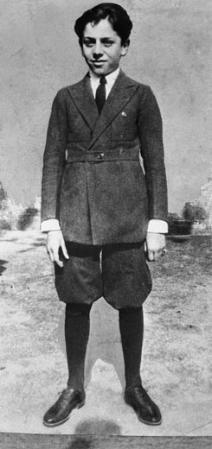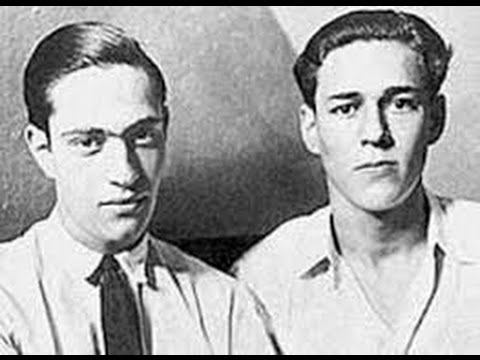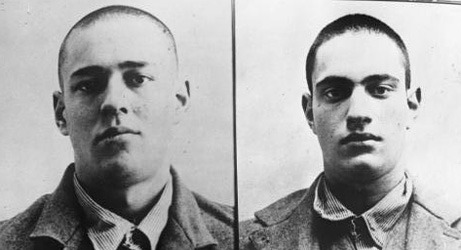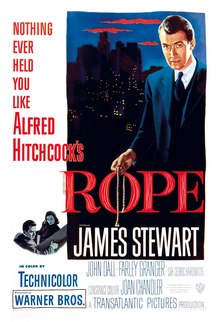Loeb (L) & Leopold (R)
Planning their gruesome intellectual adventure for seven months (everything from where to hide the body to good alias names is discussed), on lovely spring Wednesday the two friends (both from the well-to-do Kenwood section of town, the pair meet while matriculating at the University of Chicago and become lovers), the duo takes a rented car (leased under the name of Morten D. Ballard) to the city's Harvard School for Boys, and there, select fourteen-year-old Robert "Bobby" Franks as their victim.

Franks
The son of millionaire pawnshop proprietor, Franks is Loeb's second cousin and next door neighbor, often playing tennis at the Loeb home (How genius is it to pick a relative and next door neighbor as your "random" victim?). Thinking nothing awry, Franks seals his fate when he is enticed into the car to discuss his new tennis racket with his relative. Driven off, the young boy will be struck over the head repeatedly with a chisel and then smothered to death (later, both will say they were behind the wheel while the other did the actual killing). Murder committed, Leopold and Loeb then dispose of the body near Wolf Lake, Indiana (an area where Leopold frequently goes bird watching ... genius again ... NOT!) ... first pouring hydrochloric acid on Franks' face, genitals, and abdomen to make identification difficult, before dumping the corpse in a culvert near the tracks of the Pennsylvania Railroad. That task taken care of, the pair then burn their victim's clothes, clean up the blood in the car, and put the kidnapping phase of their plan into motion ... calling the Franks home and sending typed ransom notes to the family (the demand is for $20,000).

The Culvert
The perfect crime that will remain unsolved forever the plan, the reality of the duo's actions proves otherwise when Irish-American Detective Hugh Patrick Byrne discovers a pair of glasses near the culvert ... glasses with an unusual hinge mechanism that only three people in the Chicago area have purchased ... one pair being sold to Nathan Leopold (although Leopold will claim he lost the spectacles two days before while birding in the area, they actually hit the ground when they fall out of his pocket while he is muscling the body into its resting place). One clue to another (the typewriter the pair discarded after writing their ransom notes is soon discovered), the trail eventually leads to Leopold (who has been hanging around reporters and police officers investigating the murder, offering theories about the crime) and Loeb ... who prove not to be Moriarty's of the criminal world, both rolling over and confessing to their actions when they are brought in for questioning on the 29th of May.

Leopold & Loeb
Heinous crime, culprits caught and confessions taken, the next stop for the pair should have been death row ... and would have been but for the money both families have to burn on purchasing defenses for their sons ... defenses in the form of the finest defense lawyer in the nation, the legendary Clarence Darrow. Money well spent, Darrow waives a jury trial and in his closing argument to the sentencing judge, Cook County Circuit Court Judge John R. Caverly, gives a 12 hour speech about the wrongs in capital punishment ... a speech so powerful that the judge is moved to sentence the teenagers to life in prison (and 99 years each for the kidnapping portion of the crime) rather than death.
L to R - Leopold, Darrow, Loeb
LIFE IN PRISON! But not for long for one of the murderers. In 1936, Loeb will get the victim's perspective on murder when he is savaged by a fellow convict in the shower room of Stateville Penitentiary (former cellmate James E. Day is enraged when his extortion threats are ignored, but gets off when authorities buy into his alibi of the killing being self defense) dying from the blood loss that comes from being slashed over fifty times with a straight razor smuggled into the prison. Lover and best friend lost, Leopold spends time teaching class at the prison's school, organizing the prison library, writing his autobiography (a pithy tome called Life Plus 99 Years), attending parole hearings, and until the staff psychologists settle him down, screaming in his cell for hours on end. Humble and regretful about the stupidity of his youth, after 33 years behind bars a parole board lets Leopold out of jail and he uses the time left to him constructively ... setting up a foundation for emotionally disturbed, retarded, and delinquent youths, moving to Puerto Rico, marrying a widowed florist, and working in a hospital as a medical technician. He dies in 1971 at the age of 66 as a result of a diabetes inspired heart attack.

Illinois Cons - Loeb & Leopold
Gone, yet not gone ... beyond the horde of magazine articles and books about the monsters, the pair now lives on as "entertainments," their story being the basis for the 1929 play by Patrick Hamilton called Rope, Alfred Hitchcock's 1948 film of the same name (the director's first Technicolor movie, famous for taking place in real time and being shot in a series of long takes lasting ten minutes each), the 1959 movie adaption of the novel Compulsion, the 1992 movie Swoon, Michael Haneke's 1997 Funny Games film (and its 2008 American remake), the 2002 film Murder by Numbers, and Stephen Dolginoff's 2005 bizarre Off-Broadway musical, Thrill Me: The Leopold and Loeb Story.

No comments:
Post a Comment